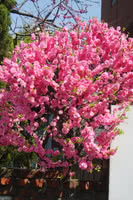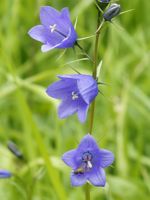Mon-Fri 9am - 5pm Mountain time
Double Flowering Plum vs Harebell
Prunus triloba Multiplex
Campanula rotundifolia
NOT AVAILABLE THIS SEASON - MIGHT RETURN
NOT AVAILABLE THIS SEASON - MIGHT RETURN
With the Double Flowering Plum in your garden, you'll be the envy of your block. Not only is it a stunning visual, but it is one of the earliest spring bloomers. With its gorgeous double pink blooms, this Plum is irresistible to birds, butterflies, and neighbours alike.
Harebell is a native perennial wildflower known for its bell-shaped, blue-violet flowers. The noddling blooms occur in clusters at the top of slender stems. Blooming in bursts from summer to fall, the flowers attract pollinators such as butterflies, bees, and hummingbirds.
Regular deadheading encourages additional blooms, extending its floral display through the season. Harebell prefers areas with cooler summer climates and does poorly in those that get too hot and humid. It is well suited for native wildflower gardens, pollinator gardens, and naturalization projects.

